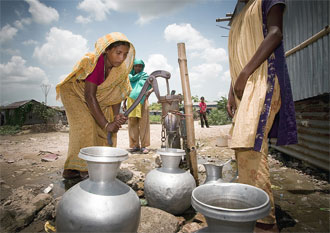DAKAR, 26 January 2009 (IRIN) – As international agencies respond to the emergence of the deadly yellow fever virus in Guinea, experts say they are increasingly concerned about a rise in outbreaks across Africa.
Africa saw 13 yellow fever outbreaks in 2008, as opposed to an average two to five per year in recent years, according to Sergio Yactayo, adviser on the World Health Organization’s (WHO) yellow fever prevention team in Geneva.
There have been four outbreaks in sub-Saharan Africa since December 2008 – in Cameroon, Central African Republic, Guinea and Sierra Leone, according to Yactayo.
“We have never had so many outbreaks in such a short period as we have now. We are very worried there could be more on the way,” Yactayo told IRIN. “We must prepare for that.”
Yellow fever is a viral haemorrhagic fever transmitted by mosquitoes. The vast majority of cases and deaths take place in sub-Saharan Africa, with 32 African countries considered to be “at risk.”
West Africa is the continent’s most-affected region, with 72 percent of the region experiencing outbreaks since 2000, according to WHO.
The fight
Agencies including WHO, the UN Children’s Fund (UNICEF), NGOs such as Médecins Sans Frontières and the International Federation of the Red Cross, and health ministries are working to control the disease in West Africa through the Yellow Fever Initiative. They plan to vaccinate 49 million people in 12 yellow fever-endemic countries by 2010 — Benin, Burkina Faso, Cameroon, Cote d’Ivoire, Ghana, Guinea, Liberia, Mali, Nigeria, Senegal, Sierra Leone and Togo.
To date, vaccinations have been completed in Burkina Faso, Mali, Senegal and Togo and Cameroon is next up, according to Yactayo.
Why the rise
The reasons for the explosion are unclear but WHO’s Yactayo said it could be linked to climate change, which in some settings can expand breeding grounds for mosquitoes.
Growing urban populations in West and Central Africa – many of them with no access to clean drinking water or sanitation facilities – also pose an increased risk, according to WHO.
“Increased virus circulation among insufficiently immunized populations in combination with the region’s rampant urbanization set the scene for an explosion of urban epidemics,” WHO reports on its website.
Urban populations in Africa are growing at 4 percent per year – the most rapid pace in the world, according to WHO.
Guinea outbreak
Following confirmation of two cases of the yellow fever virus in Faranah, central Guinea, international agencies on 26 January launched a mass vaccination campaign.
The campaign follows an emergency response in Sierra Leone that targeted over half a million people in Bo District.
Agencies including WHO and UNICEF, alongside NGOs, the Guinean Ministry of Health and the Global Alliance for Vaccines and Immunization network aim to vaccinate 60,485 people, or 36 percent of Faranah’s population, over the next week.
The campaign will target only those not covered in a 2003 vaccination campaign, and will focus on high-risk areas such as markets and on vulnerable groups including children aged 9 months to six years, Yactayo said.
He said that in some pockets of Faranah just half of the population was covered in the 2003 campaign. “This is often the case, because people may be ill, they may not show up, or they may be away at the time, so you can rarely vaccinate everyone,” he said.





